INSTITUT SUPERIEUR D'ANTHROPOLOGIE
INSTITUTE OF ANTHROPOLOGY
ONLINE COURSES / COURS A DISTANCE
FALL TERM : OCTOBER 2015
REGISTER NOW
EGYPTE – 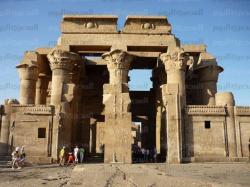 Kom Ombo - Strong winds in the Aswan Governorate have destroyed a part of the Kom Ombo Temple in the Aswan Governorate. “The section is being replaced,” said Nasr Salama, director of the Aswan and Nubia archeological sites, adding that the wind caused four tiles from the suspended ceiling of the Crocodile Museum inside the temple to fall. “The tiles did not break.”
Kom Ombo - Strong winds in the Aswan Governorate have destroyed a part of the Kom Ombo Temple in the Aswan Governorate. “The section is being replaced,” said Nasr Salama, director of the Aswan and Nubia archeological sites, adding that the wind caused four tiles from the suspended ceiling of the Crocodile Museum inside the temple to fall. “The tiles did not break.”
http://www.egyptindependent.com//news/strong-wind-destroys-part-kom-ombo-temple
IRLANDE – 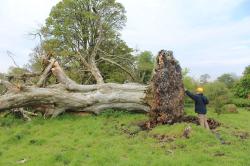
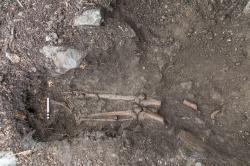 Collooney - When winter storms blew over a 215-year old beech tree outside Collooney, Sligo, a human skeleton was brought up in the root system. The National Monuments Service commissioned SLAS to undertake a rescue excavation and retrieve the badly disturbed remains. The burial was that of a young man (17-20 years old) and preliminary analysis indicates he suffered a violent death during the early medieval period (radiocarbon date: 1030-1200 AD). Several injuries were visible to the ribs and hand, probably inflicted by a knife. He had been given a formal Christian burial, however. As the photos show, the lower leg bones remained in the grave; but the upper part of the body was entangled in the tree roots and raised up into the air. Analysis of the skeletal remains is currently underway.
Collooney - When winter storms blew over a 215-year old beech tree outside Collooney, Sligo, a human skeleton was brought up in the root system. The National Monuments Service commissioned SLAS to undertake a rescue excavation and retrieve the badly disturbed remains. The burial was that of a young man (17-20 years old) and preliminary analysis indicates he suffered a violent death during the early medieval period (radiocarbon date: 1030-1200 AD). Several injuries were visible to the ribs and hand, probably inflicted by a knife. He had been given a formal Christian burial, however. As the photos show, the lower leg bones remained in the grave; but the upper part of the body was entangled in the tree roots and raised up into the air. Analysis of the skeletal remains is currently underway.
https://www.facebook.com/Sligo-Leitrim-Archaeological-Services-1484213398546571/timeline/
ROYAUME UNI –  Lichfield - Fifty well-preserved skeletons of travellers hoping for miracle cures discovered on former hospital site. The skeletons of scores of medieval pilgrims who came to the shrine of St Chad in Lichfield but died without receiving the miracle healing they hoped for are being excavated on the site of an ancient hospital that provided accommodation for travellers. At least 50 startlingly well preserved and neatly buried skeletons were uncovered during development work to build apartments on the site of the 12th-century St John’s hospital, which still provides sheltered accommodation for elderly people. “The remains are currently being processed … and, once cleaned, will be aged and sexed and examined for signs of injury, disease, dietary deficiency and other pathologies,” he said. “These tests can often reveal fascinating aspects of life, medical practice and life expectancy in medieval populations. This could provide us with a truly fascinating window into the past.” The shrine of St Chad, a Northumbrian saint who died of plague in AD672, stood at the heart of the church that became Lichfield cathedral. It became a major pilgrimage site, attracting the devout from across Britain and overseas. It was broken up in the dissolution of the monasteries and the relics scattered – although bones claimed to be the saint’s turned up a century later and are now preserved at Lichfield and at Birmingham cathedral. A spectacularly carved limestone angel, believed to have been part of the tomb, was discovered in 2006. St John’s hospital was built just outside one of the main medieval gates of the city because travellers who arrived after dark would not have been allowed in. The study of the remains may reveal the conditions that brought the pilgrims to the shrine.
Lichfield - Fifty well-preserved skeletons of travellers hoping for miracle cures discovered on former hospital site. The skeletons of scores of medieval pilgrims who came to the shrine of St Chad in Lichfield but died without receiving the miracle healing they hoped for are being excavated on the site of an ancient hospital that provided accommodation for travellers. At least 50 startlingly well preserved and neatly buried skeletons were uncovered during development work to build apartments on the site of the 12th-century St John’s hospital, which still provides sheltered accommodation for elderly people. “The remains are currently being processed … and, once cleaned, will be aged and sexed and examined for signs of injury, disease, dietary deficiency and other pathologies,” he said. “These tests can often reveal fascinating aspects of life, medical practice and life expectancy in medieval populations. This could provide us with a truly fascinating window into the past.” The shrine of St Chad, a Northumbrian saint who died of plague in AD672, stood at the heart of the church that became Lichfield cathedral. It became a major pilgrimage site, attracting the devout from across Britain and overseas. It was broken up in the dissolution of the monasteries and the relics scattered – although bones claimed to be the saint’s turned up a century later and are now preserved at Lichfield and at Birmingham cathedral. A spectacularly carved limestone angel, believed to have been part of the tomb, was discovered in 2006. St John’s hospital was built just outside one of the main medieval gates of the city because travellers who arrived after dark would not have been allowed in. The study of the remains may reveal the conditions that brought the pilgrims to the shrine.
http://www.theguardian.com/science/2015/sep/14/skeletons-medieval-pilgrims-lichfield
ITALIE – 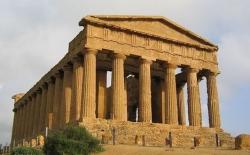 Agrigente - Two skeletons that were found just a few meters from the famous Temple of Concordia at Agrigento's Valley of the Temples could help shed new light on the history of the Sicilian Unesco site. The skeletons of two men were discovered late last week and need to undergo analysis before they can be dated exactly, but it is thought they date back to the seventh century A.D. “The find is important because it shows a human presence in the city during the post-classical age,” Valentina Caminneci, an archaeologist at Agrigento's Valley of the Temples, told the Local. While the site is world-famous for its seven well-preserved Greek temples, less is known about its more recent history. Lately, scholars have been trying to understand more about what happened to the site following the fall of the Roman Empire. “We already know so much about the site in the classical period but now we are discovering its later history, which is the next step,” Caminneci explained. The new finds date to a time shortly after Temple of Concordia was converted from a Pagan temple into a Christian basilica by the archbishop Gregory of Agrigento. Scholars now believe that a cemetery might have existed in front of the temple after it had been converted into a Christian church - but more digs will need to be carried out to be sure.
Agrigente - Two skeletons that were found just a few meters from the famous Temple of Concordia at Agrigento's Valley of the Temples could help shed new light on the history of the Sicilian Unesco site. The skeletons of two men were discovered late last week and need to undergo analysis before they can be dated exactly, but it is thought they date back to the seventh century A.D. “The find is important because it shows a human presence in the city during the post-classical age,” Valentina Caminneci, an archaeologist at Agrigento's Valley of the Temples, told the Local. While the site is world-famous for its seven well-preserved Greek temples, less is known about its more recent history. Lately, scholars have been trying to understand more about what happened to the site following the fall of the Roman Empire. “We already know so much about the site in the classical period but now we are discovering its later history, which is the next step,” Caminneci explained. The new finds date to a time shortly after Temple of Concordia was converted from a Pagan temple into a Christian basilica by the archbishop Gregory of Agrigento. Scholars now believe that a cemetery might have existed in front of the temple after it had been converted into a Christian church - but more digs will need to be carried out to be sure.
VIDEO = http://www.thelocal.it/20150914/skeletons-unearthed-at-valley-of-temples
JORDANIE – 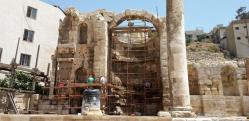 Amman - Around the corner of a busy downtown Amman street, as customers bargain with vendors over vegetable prices and passers-by flip through books at a nearby kiosk, archaeology students are hard at work restoring some of the past glory of the Nymphaeum. The site, currently closed to tourists, dates back to the Roman era when Amman was a Decapolis city named Philadelphia, but residents and passers-by had been ignoring it, thinking that it is an old, abandoned building, according to Mohammad Khalili, associate professor of architecture and heritage restoration at the Hashemite University.Years of disrepair, pollution and urban expansion have taken their toll on the site, but Khalili is determined to bring back a semblance of its grandeur.
Amman - Around the corner of a busy downtown Amman street, as customers bargain with vendors over vegetable prices and passers-by flip through books at a nearby kiosk, archaeology students are hard at work restoring some of the past glory of the Nymphaeum. The site, currently closed to tourists, dates back to the Roman era when Amman was a Decapolis city named Philadelphia, but residents and passers-by had been ignoring it, thinking that it is an old, abandoned building, according to Mohammad Khalili, associate professor of architecture and heritage restoration at the Hashemite University.Years of disrepair, pollution and urban expansion have taken their toll on the site, but Khalili is determined to bring back a semblance of its grandeur.
http://www.jordantimes.com/news/local/archaeologists-mission-breathe-life-long-abandoned-downtown-site
INDE – 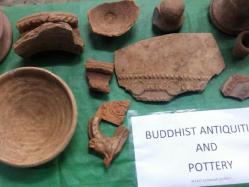 Kummarilova - With the East Godavari district officials making arrangements to complete the Indira Sagar (Polavaram) left canal works, Buddhists and heritage lovers are expressing serious concerns over the digging works that pass through Kummarilova village near Tuni, a site where remains of Buddhist pottery dating back to the Satavahana period are being unearthed by the department of Archaeology.
Kummarilova - With the East Godavari district officials making arrangements to complete the Indira Sagar (Polavaram) left canal works, Buddhists and heritage lovers are expressing serious concerns over the digging works that pass through Kummarilova village near Tuni, a site where remains of Buddhist pottery dating back to the Satavahana period are being unearthed by the department of Archaeology.
http://www.thehindu.com/news/national/andhra-pradesh/polavaram-heritage-lovers-worry-over-damage-to-relics/article7649882.ece
CANADA –  Montreal - «Préservation», «mise en valeur», «richesse patrimoniale», «découvertes archéologiques», «importance historique». Les politiciens n'avaient que des bons mots pour les vestiges du village des Tanneries, dimanche. Pourtant, quelques instants plus tôt, des experts du gouvernement venaient tous juste d'expliquer que le site serait bel et bien détruit et les sols complètement remplacés pour y accueillir une nouvelle route du futur échangeur Turcot. On parle de vestiges de bâtiments, d'outils de travail des tanneurs, ou d'objets de la vie quotidienne datant de la fin du 18e siècle, du 19e et du 20e siècle. Frank Rochefort, archéologue au ministère des Transports du Québec (MTQ), a souligné que les occasions de fouiller une tannerie artisanale ne sont pas nombreuses. Les ministres Robert Poëti et Hélène David accompagnés du maire de Montréal Denis Coderre se sont plutôt concentrés sur l'annonce de la création d'un comité qui sera chargé de trouver un projet pour mettre en valeur les 150 caisses d'artéfacts récupérées sur le site. Un relevé 3D des structures sera également réalisé en guise de «mémoire virtuelle».
Montreal - «Préservation», «mise en valeur», «richesse patrimoniale», «découvertes archéologiques», «importance historique». Les politiciens n'avaient que des bons mots pour les vestiges du village des Tanneries, dimanche. Pourtant, quelques instants plus tôt, des experts du gouvernement venaient tous juste d'expliquer que le site serait bel et bien détruit et les sols complètement remplacés pour y accueillir une nouvelle route du futur échangeur Turcot. On parle de vestiges de bâtiments, d'outils de travail des tanneurs, ou d'objets de la vie quotidienne datant de la fin du 18e siècle, du 19e et du 20e siècle. Frank Rochefort, archéologue au ministère des Transports du Québec (MTQ), a souligné que les occasions de fouiller une tannerie artisanale ne sont pas nombreuses. Les ministres Robert Poëti et Hélène David accompagnés du maire de Montréal Denis Coderre se sont plutôt concentrés sur l'annonce de la création d'un comité qui sera chargé de trouver un projet pour mettre en valeur les 150 caisses d'artéfacts récupérées sur le site. Un relevé 3D des structures sera également réalisé en guise de «mémoire virtuelle».
http://www.lapresse.ca/actualites/montreal/201509/13/01-4900174-la-destruction-des-vestiges-du-village-des-tanneries-est-confirmee.php
INDE –  Alamgirpur - A 5000-year-old Indus Valley settlement located in Baghpat district of Uttar Pradesh, stands abandoned and unprotected. The archaeological site, discovered in 1957 in Alamgirpur village of the district, is regarded as one of the most historically significant finds in the country as it showed for the first time evidence of habitation pertaining to the Harappan period in the Upper Doab region between the Ganga and the Yamuna. However, at present the settlement, which lies just 70 km. from the national capital, faces destruction by the villagers who have flattened the centuries-old structures to expand their cultivable land. Worse, some of the villagers have built houses, memorials and temple-like structures on top of the settlement, where excavations till last year had given crucial insights about life and society during the Harappan period, also known as the Indus Valley Civilization. During excavations of the site which dates back to the Harappan period of 3300-1300, the ASI archaeologists found ceramic items like roof tiles, dishes, terracotta cakes and figurines of a humped bull and a snake. After its discovery the site was declared “protected.” But it is anything but that now.
Alamgirpur - A 5000-year-old Indus Valley settlement located in Baghpat district of Uttar Pradesh, stands abandoned and unprotected. The archaeological site, discovered in 1957 in Alamgirpur village of the district, is regarded as one of the most historically significant finds in the country as it showed for the first time evidence of habitation pertaining to the Harappan period in the Upper Doab region between the Ganga and the Yamuna. However, at present the settlement, which lies just 70 km. from the national capital, faces destruction by the villagers who have flattened the centuries-old structures to expand their cultivable land. Worse, some of the villagers have built houses, memorials and temple-like structures on top of the settlement, where excavations till last year had given crucial insights about life and society during the Harappan period, also known as the Indus Valley Civilization. During excavations of the site which dates back to the Harappan period of 3300-1300, the ASI archaeologists found ceramic items like roof tiles, dishes, terracotta cakes and figurines of a humped bull and a snake. After its discovery the site was declared “protected.” But it is anything but that now.
http://www.thehindu.com/news/national/other-states/harappan-settlement-razed-to-expand-farmland-build-houses/article7648832.ece
SRI LANKA – 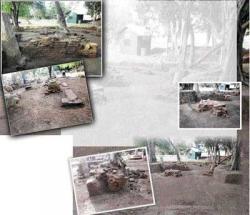 Situlpawwa - Recent archaeological excavations at the Magul Maha Viharaya site at Situlpawwa in Tissamaharama have yielded evidence to date the monastery to the Second Century BC, Director General of Archaeology Dr Senarath Dissnayake said yesterday. Among the finds were a Bodhigharaya (sacred enclosure for the Bo tree) that could be assigned to the First Century BC, Prof. Dissanayake said. "The brick wall of the enclosure was 35 metres in length and 18 meters in width. There were pot shards with Brahmi script inscriptions belonging to the Second Century BC. There were red and black ware pottery of begging bowls used by the then Bhikkhus. The excavation process is now over and we are planning the conservation process." According to the folklore the monastery was established during the reign King Kavantissa. Dr Dissanayake said: "There are caves that have the ‘kataram’ carving, which is a groove or channel cut along the top of the overhanging rock, to prevent water dripping into the caves, and many rock inscriptions. There is evidence of ruins of three stupas near the site. Around them ruins of rock pillars and buildings of the ancient past have been uncovered." Folklore records that the site got its name because it was the place where King Kavantissa had the engagement ceremony with Vihara Maha Devi, who became the King’s consort and gave birth to Prince Dutu Gemunu, Dr Dissanayake said, adding that there was however no archaeological evidence to prove it. We have no evidence to ascertain the nature of relationship this monastery had with nearby monastery at Sithul Pawwa, but according to an inscriptions found in the site, both temples had received the patronage and sponsorship of Gotimbara, one of the ten giant warriors of Dutu Gemunu." According to the references in chronicles, this site was used during the battle by the Vijayabahu the Great to unite the country. The Mahavamsa has a reference to the effect that Vijayabahu organised his troops at a site called Paluttagiriya. Renowned historian C.W. Nicholas has identified Paluttagiriya as what we know today by the name Palatupana in the Hambantota District and the site under scrutiny is the place where the king raised his army.
Situlpawwa - Recent archaeological excavations at the Magul Maha Viharaya site at Situlpawwa in Tissamaharama have yielded evidence to date the monastery to the Second Century BC, Director General of Archaeology Dr Senarath Dissnayake said yesterday. Among the finds were a Bodhigharaya (sacred enclosure for the Bo tree) that could be assigned to the First Century BC, Prof. Dissanayake said. "The brick wall of the enclosure was 35 metres in length and 18 meters in width. There were pot shards with Brahmi script inscriptions belonging to the Second Century BC. There were red and black ware pottery of begging bowls used by the then Bhikkhus. The excavation process is now over and we are planning the conservation process." According to the folklore the monastery was established during the reign King Kavantissa. Dr Dissanayake said: "There are caves that have the ‘kataram’ carving, which is a groove or channel cut along the top of the overhanging rock, to prevent water dripping into the caves, and many rock inscriptions. There is evidence of ruins of three stupas near the site. Around them ruins of rock pillars and buildings of the ancient past have been uncovered." Folklore records that the site got its name because it was the place where King Kavantissa had the engagement ceremony with Vihara Maha Devi, who became the King’s consort and gave birth to Prince Dutu Gemunu, Dr Dissanayake said, adding that there was however no archaeological evidence to prove it. We have no evidence to ascertain the nature of relationship this monastery had with nearby monastery at Sithul Pawwa, but according to an inscriptions found in the site, both temples had received the patronage and sponsorship of Gotimbara, one of the ten giant warriors of Dutu Gemunu." According to the references in chronicles, this site was used during the battle by the Vijayabahu the Great to unite the country. The Mahavamsa has a reference to the effect that Vijayabahu organised his troops at a site called Paluttagiriya. Renowned historian C.W. Nicholas has identified Paluttagiriya as what we know today by the name Palatupana in the Hambantota District and the site under scrutiny is the place where the king raised his army.
http://www.island.lk/index.php?page_cat=article-details&page=article-details&code_title=131708